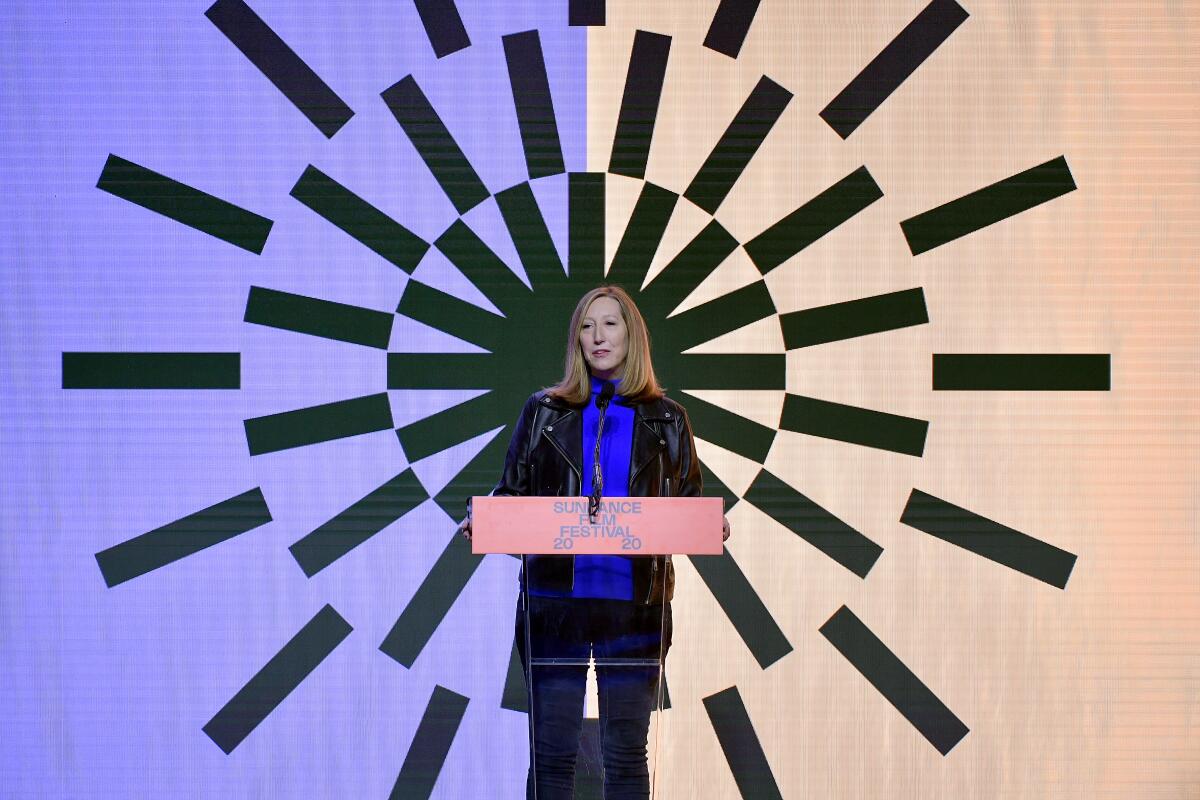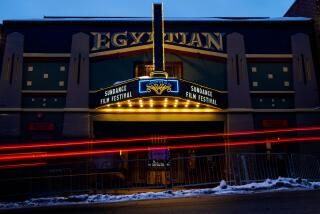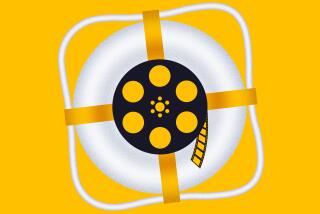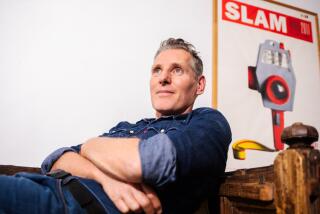Sundance Institute launches $1-million fund to support indie film during coronavirus crisis

In response to the COVID-19 pandemic, Sundance Institute has established a $1-million emergency relief fund for independent artists and arts organizations.
One-third of the fund will go to the approximately 100 participants in the 2020 spring and summer Sundance labs. One-third of the grants will be open to artists across the U.S. in partnership with the new cross-disciplinary, need-based fund Artist Relief. The final third of the money will support U.S. and international independent artist organizations.
A statement signed by Sundance Institute executive director Keri Putnam, founding director of Sundance’s feature film program Michelle Satter and recently installed director of the Sundance Film Festival Tabitha Jackson read in part, “To put it bluntly: There can be no return to business as usual. When history looks back, this will either be the moment when we invested in artists, making it possible to turn what we’re feeling during these scary and surreal times into powerful, lasting creative work — or it will be the moment we lost a generation of art and artists because we failed to support them when and how they most needed it.”
The details on criteria and the application process are available at Sundance.org, while applications for funds from Artist Relief can be found at artistrelief.org
Sundance has already been grappling with changes forced by the novel coronavirus — shifting many live programs to virtual events, postponing festival events in London and Hong Kong, and making content on the Sundance Co//ab website — typically available only to paid members — free to anyone.
The website, which contains resources such as webinars, master classes and other educational and informational tools, has already seen a massive spike in usage since becoming free to all.
Seven national grant-making groups have banded together to launch the Artist Relief Fund, which will provide $5,000 payments to artists in dire need.
On Thursday, Putnam spoke to The Times about the inspiration and implementation of the Institute’s ambitious relief fund and what the post-pandemic future of the Sundance Film Festival might look like.
What was the inspiration to start the fund and for Sundance Institute to take this kind of action?
Keri Putnam: It was really important for us to figure out a way to do what we could in a time of great challenge for all nonprofits to get funds to the artists who are most in need. And to do that in a way that felt consistent with what we do as an organization and the partners and collaborators we have. So the inspiration was really just the mission, which is to support artists so that they can inspire and connect and improve the culture we all live in.
Whether it’s people who are already part of the Sundance community or others, had you been hearing from a lot of people in need, who were looking for resources or answers?
Putnam: We spent the first month, or however long we’ve been home ... just making sure our teams and the impacts on us were managed, because it has been challenging, of course. But the better part of our time on behalf of all the staff at Sundance has been just being out there and listening. We did a whole survey of our community and beyond. We’ve been talking to partners and colleague organizations, other nonprofits. The impact on independent artists — who are largely freelancers and largely left out of a lot of thinking in terms of who needs help — is real.
Not just in the disruption of their work, but also in many cases their personal safety, security and livelihoods. So yes, we heard that loud and clear and I think artists of all kinds need to be remembered as important parts of our culture and economy that need to be supported. So we heard that from our group and we partnered with a group [Artist Relief] that’s dealing with artists in other disciplines and they’ve heard the same.
And then what of the additional step of thinking structurally to become involved with supporting other institutions?
Putnam: I think that is one of the most important pieces of this actually. There’s several pieces of it that are very different from what we typically do at Sundance. And I think that’s what this moment requires — for all of us to dig deep and really listen and try to respond to the moment that’s out there. And that involves doing things differently than we would typically do, but being connected to the purpose behind it. So for us, the question of supporting other organizations was part of a whole idea of moving beyond the curated groups that we typically work with in our programs.
That’s what this moment requires — for all of us to dig deep and really listen and try to respond to the moment that’s out there.
— Keri Putnam, executive director of Sundance Institute
You know, we’re about to start our lab season. A huge part, that a lot of people aren’t aware of, of what Sundance does is support artists at earlier stages making new work, supporting people that we believe have incredible projects, incredible talent and we want to help them grow and become the next artists that we’ll see at the festival and beyond. That group of artists is still going to be getting support from us, not just creatively and strategically and tactically, but our selected artists will get a third of these funds. That’ll be an important piece of what we do because it’s consistent with what we’d done. But two-thirds of this funding is actually being deployed in a need-based way exclusively. And that’s a really important difference for us. We don’t typically grant that way, because it just hasn’t been our practice, but it’s what is required right now.
To answer your question about other organizations, we really wanted to focus on organizations who were working with historically underrepresented communities. We all in this ecosystem need these organizations. We can’t do the work we do without them, and they’re a vital part of the ecosystem as they’re doing development work and curatorial work with artists all the time. So this was a very natural outgrowth of that. And then also feeling like we wanted to recognize that by focusing on underrepresented communities with this group, through the organizations that are working most closely with those communities, we were also reflecting the inequity in the way we see the COVID playing out in terms of the disproportionate impact on, for example, communities of color. And so that felt like a piece of this too.
The million dollars that’s being set aside for all this, is that a reallocation of funds Sundance already had or have you brought in new funds specifically for this purpose?
Putnam: It’s a great question and one that’s really important. This is a way we decided to redeploy in partnership with some amazing funders that we have, the funds we have. And I’ll talk about how we did that. The first is we had to adapt all of our lab programs, our fellowship programs — it was 58 programs we adapted to digital that would have been live. And there’s a lot of costs behind doing something, flying people in and venues, all that sort of stuff that is different when it goes into digital. We were able to reserve some of that savings to put into this fund in one piece, because it’s just a different way of supporting artists.
And then we went to the funders who support some of our granting ... all of them generously agreed to lift the restrictions on the original uses that they had provided for the money ... so that we were able to be more flexible and pull together this fund. At the same time we’ve been hit ourselves as a nonprofit with a loss of revenue as so many nonprofits have been. And we’ve been working to shore that up. But we felt it was very important to remain true to what our mission was and to get this resource that we had dedicated for artists out to artists in the way that was most urgent now.
Do you know how quickly you’re going to be able to disburse these funds? And how long do you expect this $1 million to last?
Putnam: Let’s be honest, a million dollars is not going to meet all the needs of this community. We hope we are doing what we can now, but this is a long game. This is about what is the response we want to make now to what we’ve heard with what we have available. And now our challenge collectively, and this is for Sundance and for the field as a whole, is to say how do the independent artists sustain themselves going forward?
None of us know how long this particular crisis will last. But I think what we do know is that coming out on the other side, there’s going to be a really important reimagining of how our field is working and how we think about supporting the artists that are within it. And it may take some time to figure out those new systems, but what’s demanded is that we continue to think about sustainable efforts. We won’t just do one and done. So this is the first thing we’re doing. We know this won’t be the last thing.
Do you have any sense yet of what the impact is going to be on the Sundance Film Festival for 2021, whether it’s going to be the pipeline of titles that are available or what the festival may even look like? Are you able to think that far ahead right now?
Putnam: I think we all have to be thinking far ahead. And I think the question of — do I have a sense of what the impact is going to be? Of course not. We don’t know what the future is going to bring exactly, but what I will say is that we’re very fortunate to have had the 2020 festival. And it’s heartbreaking to see so many of our colleagues who did have to cancel their events because of what’s going on right now, as well as the artists affected by that.
If live events are impacted, no one’s going to be exempt from that. We are definitely concerned and we’re looking at multiple scenarios, but right now we’re planning for an in-person festival in Park City in 2021 and I think we see through all of this even more clearly the importance of gathering as a community. And we hope that, both in terms of the work that’s going to be available, obviously there’s been a disruption in production, but there’s also a lot of work being made and we’re confident that we’re going to have both the creative work and the opportunity to create a great festival in January. Exactly what shape that takes, we won’t know. But that’s the plan.
More to Read
Only good movies
Get the Indie Focus newsletter, Mark Olsen's weekly guide to the world of cinema.
You may occasionally receive promotional content from the Los Angeles Times.










